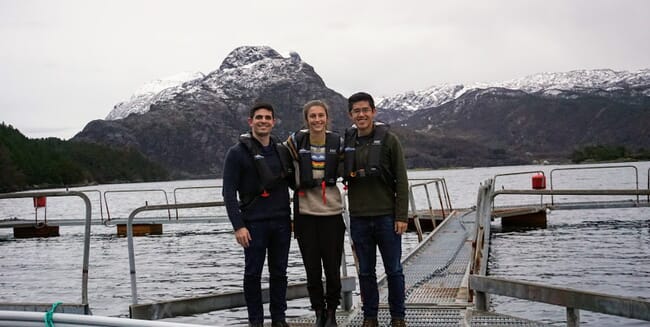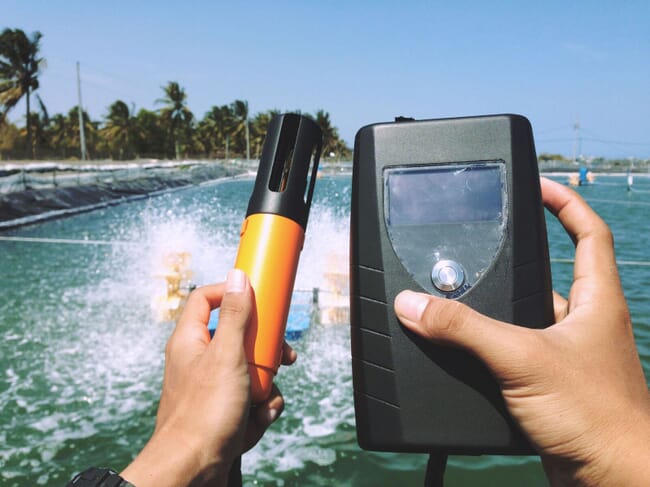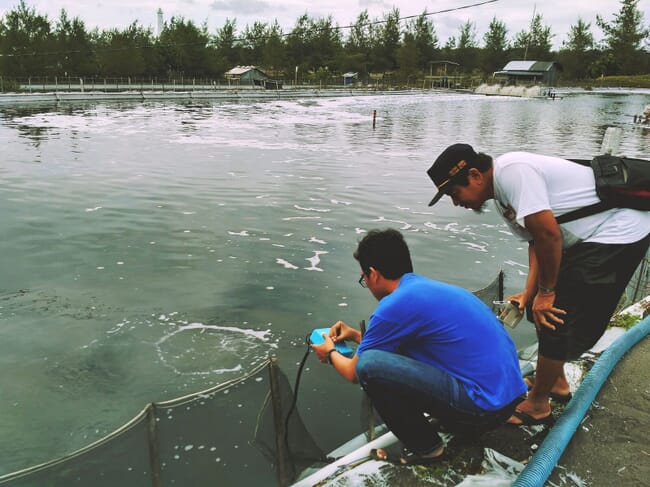The promise of Big Data
The biggest argument in favour of using Big Data in aquaculture is that it improves management of farming activities. Big Data systems provided by Manolin and XpertSea take a holistic view of the industry. XpertSea is built around devices that are synchronised to a single platform, which manages all aspects of production – allowing producers to save time and energy. Since huge amounts of site-and operation-specific data is generated, the platforms can facilitate benchmarking, and let farmers track and compare their yields.

© Manolin
Similar to “smart farming” in land-based agriculture, such applications of the digital revolution can help fish farmers track health information on the animals they raise. Disease outbreaks, fish lice infestations, water quality and mortalities can be analysed by the new technology. Big Data and artificial intelligence (AI) can also establish algorithms for farmers to follow. These algorithms can help producers boost productivity, improve their feed conversion rates and send alerts if their fish encounter biological stress. The added precision that comes from adopting digital technology and AI also allows producers to be more accurate when delivering products and managing costs.
An additional management benefit can be seen in products like Jala, a Big Data solution geared towards shrimp growers. Jala can easily organise and export data – meaning that sites can readily submit information to regulators, insurance companies or researchers should the need arise. In the case of Manolin, users can share information with other farming operations to compare yields or notify their neighbours of disease outbreaks.

© Jala
Big Data innovations don’t stop at user platforms. XpertSea has developed the XperCount to monitor hatching, feeding and post-production. Technologies like Cermaq’s iFarm have been able to repurpose facial recognition software to identify individual fish suffering from sea lice. SINTEF ACE, a research lab in Norway, has developed autonomous vehicles and robots for labour-intensive tasks such as maintenance and inspection. The vehicles are able to perform jobs in adverse conditions – an innovation that could make the profession safer. In this case, it’s easy to see how these technologies can be adapted to multiple points of the aquaculture supply chain.
Though current users of the technology are best thought of as “early adopters”, the data they are submitting will only improve the predictive power of the various algorithms. Similar advancements in robotics technology could mean that automated vehicles could be accessible to more producers. According to Markets Insider, widespread adoption of autonomous vehicles in aquaculture will happen in the next decade.
The downside of digital
It’s easy to see the benefits of Big Data based on the sales pitch, but from a user’s perspective, adopting the technology could have some drawbacks. Big Data has the potential to create data-rich, but information poor (DRIP) systems. Much of the technology is predicated on collecting multiple data points. However, if the systems cannot provide analysis or recommendations based on the collected data, operations using the new tech won’t reach their full productive potential. In this case, investing in platforms and infrastructures with DRIP issues may not be the best use of resources for farming operations.
Big Data systems could raise other ethical issues as well. The central question is: who owns the data that’s being produced? Similar questions of ownership emerged when smart farming was introduced to land-based agriculture. Depending on the platform being used, data ownership could fall to the producer or the tech company or venture capital firm. If tech companies owned the data, then farmers would not have full control over the information coming from their sites. Theoretically, this data could be shared with third parties without users’ consent. It could also create a dynamic where tech companies and venture capital firms have significantly more negotiating power than producers when it comes to contracts.
Tech companies face an additional challenge when creating aquaculture algorithms. Namely, how often these algorithms are reviewed and updated, and what the central aim of the algorithm is. The algorithms could prioritise standard industry practices, serve the needs of regulators or try to incorporate new research innovations. Without significant input from aquaculturists and coordination with other industry stakeholders, the algorithms may stagnate, reinforce the status quo or fail to prioritise the needs of producers. As it stands now, the ethical issues regarding data ownership and the purpose of the algorithms haven’t been resolved.

© Jala
An additional concern for those adopting Big Data or automated solutions for aquaculture is economic. Though companies like Manolin offer a free platform for users, the autonomous vehicles in development would require producers to remodel their farming systems. Investing in the infrastructure needed to host the data can be expensive and may be out of reach for some fish farming operations. Since these systems may only be available to highly profitable producers, it could present a financial barrier to other businesses in the market. It could also create a two-tiered system within the industry where large operations using the technology will rapidly expand and smaller producers who can’t make that investment won’t be able to compete.
Disruptive potential
Big Data has the potential to change the character of the industry. As it stands now, aquaculture is a “hands on” industry. Producers and operators often have to manually handle the specimens they raise to deliver medical treatments or get accurate counts as the fish mature. Working on-site carries a high risk of personal injury. Based on an industry study in Washington state, the most common type of work-related injury is being struck by or against an object – something that can easily happen when operators have to physically enter tanks and ponds to conduct maintenance work.
Conversely, Big Data and AI could transition many farming operations into “hands off” endeavours. Platforms like Manolin and XpertSea allow producers to manage the operation from a smart device, and the connected buckets and sensors from Jala can collect data without manually handling the fish. The introduction of autonomous vehicles could reduce the risk of injury for employees as well.
Automating processes in aquaculture could also change the nature of the sector, especially in terms of labour practices. Similar to other industries, automation can reduce the demand for workers who perform routine manual tasks. This reduction in demand could become an issue in emerging economies where people may rely on manual aquaculture work as a source of income. Widespread adoption of automation could drastically change the work arrangements and economics of fish farming.
Data dilemmas
Many of the innovations in this sector will rely on 5G technology and the Internet of Things (IoT). 5G networks will host infrastructure capable of carrying huge amounts of data. The data will allow more devices to communicate and coordinate with one another, automating and streamlining labour-intensive processes like monitoring and feeding. 5G technology could also support unmanned robots in pens and ponds. Testbeds for 5G technology are already live and networks are expected to launch across the world by 2020.
According to Techradar, upgrading to 5G networks will provide more reliable connections and faster speeds for smartphones and other devices. Although these innovations could revolutionise aquaculture practices, the devices could present significant security issues when they are adopted. 5G compatible devices are still susceptible to hacking and providers don’t agree on how to ethically handle the data 5G produces. Chinese telecoms giant Huawei is facing scrutiny over fears that the company’s devices could be used to spy for the Chinese government. Japan and the US cited this fear when banning the company from developing 5G infrastructure in their respective countries. For aquaculture specifically, embracing 5G without nailing down the specifics of data ethics presents a significant challenge. Producers could unwittingly give state organisations or adversarial governments access to data on strategic food supplies – this information could easily be weaponised or politicised.
There are multiple reasons why Big Data and AI should be welcomed in aquaculture; the management platforms can help treat diseases and automation can make the profession safer for workers. However, the digital revolution could change the character of the industry and disrupt labour practices. The industry will need to engage with stakeholders and prioritise data ethics in order to avoid the pitfalls of adopting the new technology.



